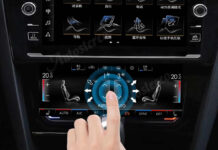Engineers have developed and tested on humans first technology of ultrasonography (us), does not require skin contact of the patient with the scanner. In addition, it is resistant to operator errors.
Achievement is described in a scientific paper published in the journal Light: Science and Applications group of the Massachusetts Institute of technology (MIT), headed by Brian Anthony (Brian Anthony).
Who from us though time in life did not pass the ultrasound procedure? This scanning technology is quite effective and is not expensive, and, unlike x-raying, harmless (for the doubters note that this has been proven in many studies).
However, the existing ultrasound machines require the item scanner attached to the body of the patient. What to do if the desired area of the skin is injured or hypersensitive? In addition, the quality of the survey depends on whether the operator presses the nozzle to the skin and is a possible source of errors.
the Technology, developed by engineers at MIT, bypasses these problems in a witty way. Ultrasound it is generated not by the device, and the patient’s skin.
the Authors used a laser with a wavelength of 1.55 micrometers (near infrared range). Radiation with this wavelength is perfectly absorbed by the water. Water entering into the composition of human skin, is no exception. Absorbing the electromagnetic wave, it heats and expands. In the intervals between pulses of the laser skin re-compressed. The portions of the radiation generated by these oscillations are issued with such frequency, to obtain the ultrasonic wave.
This description may sound intimidating. But the researchers emphasize that the level of radiation is absolutely safe even for eyes, not to mention the skin, even injured or sensitive.
the Ultrasound enters the patient’s body, reflected from various tissues and absorbing the information on them, as in conventional ultrasound. The reflected wave returns to the surface of the body.
the Skin meanwhile, SKanirul other laser. Catching the smallest offset, it reads the characteristics of emergent ultrasound in the distance.
and it turns out the ultrasound, in which mechanical contact with the skin of the patient is not required nor to guide him in his body ultrasonic wave or to fix the results.
 the Image of the dead tissues of the pig, obtained by a new method (left) and traditional ultrasound (right).Illustration Zhang, Anthony et al. Light Sci Appl 8, 119 (2019).
the Image of the dead tissues of the pig, obtained by a new method (left) and traditional ultrasound (right).Illustration Zhang, Anthony et al. Light Sci Appl 8, 119 (2019).
the Researchers tested their creation in several stages. First they put a metal object in a gelatin shell, at water content close to the skin. Scan standard ultrasound probe and its method, scientists have discovered a promising similarity of the images.
Then came the turn of the tissues of a dead pig. At this stage, the authors made sure that the device allows to distinguish the boundaries between muscle, fat and bone.
Finally, the technology has been tested in humans. Several healthy volunteers, the scientists scanned the forearm to a depth of about five centimeters. It turned out that the boundaries between tissues of different type is quite clearly visible on the scan. The quality of this survey are comparable with the standard.
Now the authors are going to improve the design to get the ability to scan the deeper tissues and to improve the detail of the created images. They also hope to make your device portable.
“I can imagine a situation where it [the survey] could be held at home, says Anthony. – Getting up in the morning, I can get a picture of my thyroid or arteries”.
By the way, earlier “News.Science” (nauka.vesti.ru) wrote about how ultrasonic lens will allow to study deep tissue and about the camera, “seeing” the human body through.
Text: Weightti.Science


















